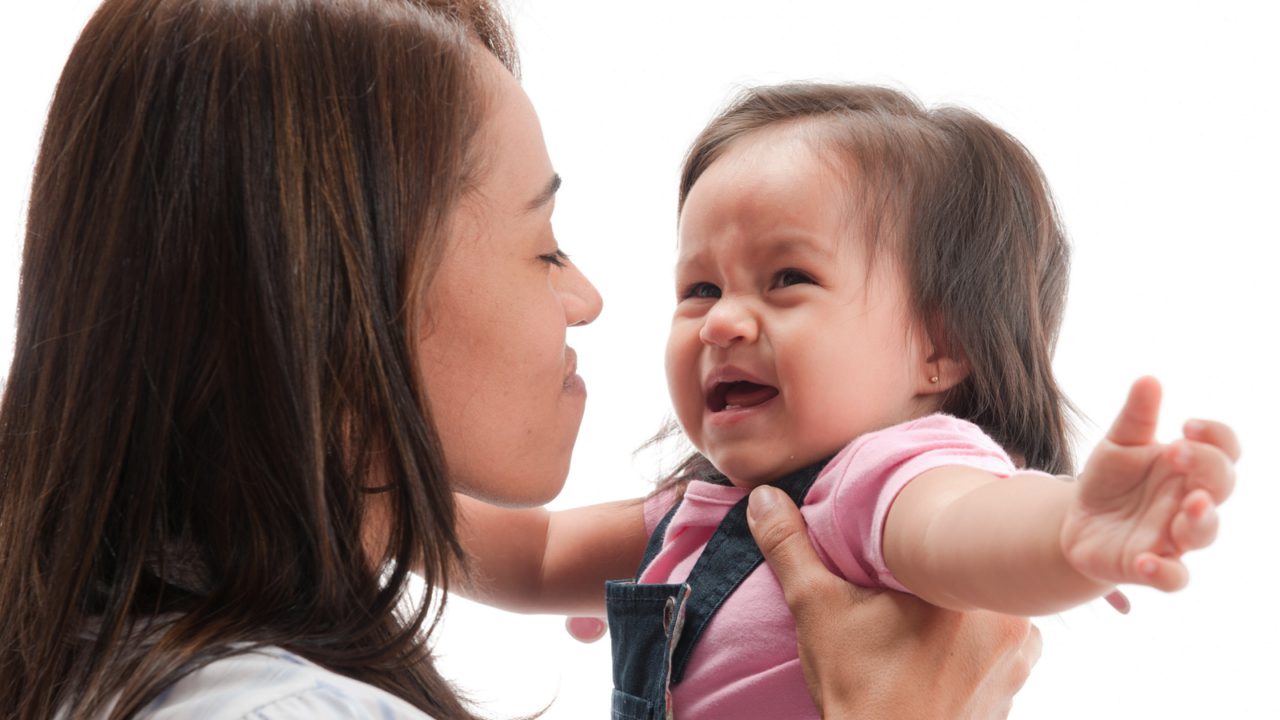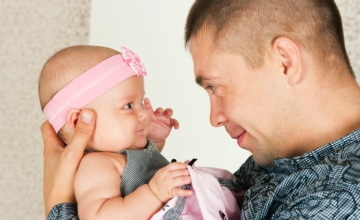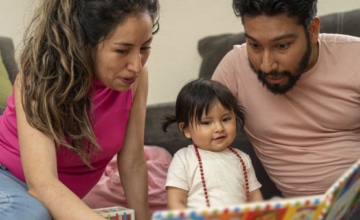By Claire Lerner
The second year of life is all about making the journey from babyhood to childhood. Browse the information and links below to see what your little one is experiencing and learning this month.
IN THIS RESOURCE
- What It’s Like for You
- What It’s Like for Baby
- What to Expect From Your Baby’s Development
- Did You Know…
- Spotlight on: Teaching Your Toddler About Cooperation
- Let’s Play: Activities That Nurture Bonding and Learning
- What’s on Your Mind?
- Expert Reviewers
What It’s Like for You
Your toddler wants to be carried in your arms. But then he wants to run ahead of you, all by myself! The second year of life is all about making the journey from babyhood to childhood. And it’s very normal for the path to be a little bumpy at times. Imagine it as a three-steps-forward, one-step-back kind of process. When toddlers take big steps toward independence or have reached a new milestone, it can lead to a sense of insecurity that they are getting too big to be cared for. They go back to “babyish” behaviors to help them feel ready to journey forward again. That can make it a confusing (and challenging) time for you. Says one father:
For days my daughter had been determined to get her own sandals on. She would push my hands away if I tried to help her. So one morning, I asked her: Gracie, how about you get your sandals on so we can go to the park? I thought I was being such a great dad, following her lead, letting her be independent. Well, she threw a fit. She didn’t want to put her shoes on by HERSELF, she wanted DADDY to do it! Tears, screaming, the works. My friend who has a son the same age just looked at me and said, I’m telling you, some days you just can’t win.
Just remember, for every step back into babyhood, there’s another leap forward into the wide and wonderful world of the “big kid.”
What It’s Like for Baby
We went to a birthday party today and there was a clown. You took me to meet him. I did NOT like him. He looked sort of like a person, but not really because his hair was so big and it was purple. And his face was bright white with a big red mouth. I know you said he was a nice clown, but he looked scary and strange to me. Then he reached out his hand to touch me. YIKES. I was so scared! That’s why I turned my face toward you and hugged you tight and started to cry. Thank you so much for taking me away from that clown and into the other room. You held onto me and said, It’s okay. You’re safe. The clown looks strange, but he is a man in a costume. He will not hurt you. But if you do not want to meet him, you can stay here with me. We stayed in the other room for a while and played with some trucks. We heard the clown sing a song. You walked with me to the doorway and held my hand while I peeked out to take a look. Then we joined the party again for cake. That clown was still there, but you chose a seat far away from him and I sat on your lap. I didn’t mind him so much as long as you were close…and he was far!
What Your Toddler Is Learning
Social-Emotional Development:
- To accept comfort and reassurance when feeling fearful
- That it is okay to express her fears. And that her parent will take her seriously and respond sensitively
- Trust that her parent will keep her safe
- That she is able to take steps toward conquering her fear with the support of her parent, like when she walks to the doorway to peek out at the clown
- To cope with challenging situations, such as when she and her parent ate birthday cake in the same room as the clown
Language and Thinking Skills:
- Words to express fear and reassurance
- The idea of what a person “should” look like. The clown (purple hair, white skin, big red mouth) does not match this child’s image of a person in important ways. However, the clown does look like a regular person in other ways (arms, legs, face, etc.). Because some parts of him are “normal” and others are not, he is scary and confusing to this toddler.
What to Expect From Your Baby’s Development
As you review the chart, keep in mind that development is not a race and that every child grows at her own pace and in her own way. Your child may develop skills faster or slower than indicated below and still be on track. If you have questions or concerns, talk with your child’s health care provider or other trusted professional.
Your Toddler’s Development From 18 to 24 Months
| What Your Baby Can Do | What You Can Do to Connect With Your Baby |
|---|---|
I am learning new words everyday. |
|
|
|
I can use my hands and fingers to do so many new things. |
|
|
|
I am learning about my own and others’ feelings. |
|
|
|
I am beginning to use my imagination. |
|
|
|
I am a little scientist, always testing things out! |
|
|
|
Did You Know…
That your toddler is already gaining self-awareness—learning who he is? Researchers put a dot of red rouge on babies’ noses (without them knowing) and then sat them in front of a mirror. The babies ranged in age from 9 to 24 months. Researchers wondered whether the babies would react to their images in the mirror by touching their own noses, which would show that the babies knew they were seeing their own faces in the mirror. None of the babies under 12 months reacted to their reflection in a way that showed they understood they were looking at themselves. However, most of the babies between 15 and 24 months did react to seeing themselves in the mirror, often by touching their own noses with an expression of surprise or curiosity. This experiment established that during this period toddlers first develop a sense of self-awareness.
What the Research Means for You
Self-awareness is the knowledge that each of us is an individual with our own body, mind, and actions that are separate and independent from other people. This understanding is the foundation for more complex emotions like empathy, pride, and self-confidence, as well as shame and embarrassment. This is a huge milestone in your toddler’s thinking and emotional skills.
How can you nurture your toddler’s self-awareness? Try these ideas.
Use mirror play. Like in the study above, give your toddler a child-safe mirror to play with. Talk about what your baby is seeing. Point to the striped shirt on his image in the mirror, then point to your child’s striped shirt.
Look at photos. Make an album of photos of your baby with the important people in her life, and at the places she regularly goes (child care, the park, etc.). Read this book together and ask your child to point to herself in the photos.
Play “Is this yours?” Along with developing a sense of “me” is understanding the concept of “mine!” You can explore this new idea through play as you sort the laundry and pull out a t-shirt belonging to your child. Ask: Is this yours? See what he says. Then pull out a shirt belonging to you: Is this yours? Games like this help your child develop self-awareness as well as memory and thinking skills.
Spotlight on: Teaching Your Toddler About Cooperation
Two 21-month-olds reach for the same bright red shovel in the sand box. One grabs, the other grabs. Tears follow while each argues to the other: Mine! One child’s father steps in and gently separates the two, handing a red shovel to one and a plastic bulldozer to the other. He shows them how one can bulldoze a pile of dirt, which the other can shovel into a bucket.
These children are learning how to resolve conflict, cope with disappointment, and build relationships through cooperative play. Cooperation is the ability to balance one’s own needs with someone else’s. We often think of cooperation as children doing what adults want. That is compliance. True cooperation means a joint effort—a give and take between two people toward a shared goal. Helping children understand how our requests and rules are good for everyone encourages a cooperative spirit.
Below are ways you can help your child develop the skill and experience the rewards of cooperating:
- Take turns. Take turns putting pieces in the puzzle or shapes in the shape-sorter. When you have completed a puzzle, notice aloud how it was your “teamwork” that helped the two of you be successful. When it’s time to clean up, make a game of taking turns placing toys back on the shelf. These experiences are opportunities for your child to feel the pleasure of accomplishing something as a team.
- Explain your reasons for limits and requests. While it isn’t until about age 3 that children understand simple explanations, you can build this skill starting now by pointing out how rules benefit the whole family. We all help clean up. Then we don’t lose our toys and we can find them again. Or, When you help me put away the laundry, I finish quicker and then we can play.
- Do chores together starting at an early age. Together you can set the table, clean up toys, or wash the car. Point out the advantages of cooperating. Look how fast we set the table. Now we have time to read a book before dinner. Or, Boy was it fun to wash the car with you. You are a great scrubber! Look how bright and shiny you made our car!
- Give specific praise for cooperative efforts. Point out why and how their contribution was important. This helps children recognize and value their skills. You put the books away on the shelf. Now it’s easier to find all of your favorites.
- Give your child choices while maintaining the rules. Teeth need to be brushed at bedtime. Do you want to do it before we read books or after? Of course, children almost always choose to do it after, but they’re less likely to protest if you are consistent about the rule and give them some control over when it happens. Offering choices shows your child respect, and respect creates a sense of collaboration.
- Use humor. It’s harder to say no when you are laughing. Plus, using humor creates fun and loving moments instead of a battle of the wills. Picture this: Your toddler doesn’t want to get pajamas on. You put his pj pants on your head. Then you run around the room frantically asking, Where are your pajamas? Have you seen them? Or, if your toddler doesn’t want a diaper change, turn the clean diaper into a puppet who calls your child’s name and starts tickling him.
- Turn on your imagination. You can walk to the bus stop, or, you can put your arms out and “fly” there like an airplane. At bathtime, pretend that your child is a fish and you are trying to make his fins very, very shiny with the washcloth. Hop like kangaroos back to the car after a trip to the park. Look for ways to bring imagination and creativity into your child’s life, and you will find that cooperation comes along for the ride.
Let’s Play: Activities That Nurture Bonding and Learning
Paint with water
Pick up some inexpensive paintbrushes from the hardware store and fill up a bucket with water. Let your toddler “paint” the sidewalk, the front steps, and anything else she finds outside. Look and see how the water changes the color of things, like making the sidewalk look darker. Games like this build fine motor skills (the use of the small muscles in her hands and fingers), which will help her learn to write later on. As with any water activity, supervise carefully and empty the bucket as soon as you are done playing.
Can you…?
Build on your toddler’s growing pride in all he can do on his own by asking, Can you spread both arms out wide? Can you touch your fingers to my fingers? Can you jump up really high! Games like this help your child develop listening skills and the ability to make a plan to accomplish a task or goal.
What’s on Your Mind?
1. My father died recently and I’ve been dealing with it okay, but I’m not sure what to do concerning my 21-month-old daughter. When we go to my parents’ house she asks for Pop-Pop and we tell her he’s not home. I can’t keep doing this. I don’t want her to just forget him, but how can you explain that someone has died to a baby?
I am very sorry for your loss. This must be a very difficult time as you need to take care of yourself and cope with your own feelings, and at the same time try and make sense of all this for your young child.
Helping your child understand what has happened to Pop-Pop is indeed a challenge, as 20-month-olds don’t understand death, or even the idea that they will never see somebody again. At the same time, children are very tuned in to the feelings of the important adults in their lives, so it is likely that your child senses your sadness and understands that there is something more going on than just Pop-Pop not being home.
The key is to respond in a way that she can understand at her age. A 21-month-old is not able yet to understand the “why” of things, so explaining what death is would be confusing to her, and would likely cause more anxiety. What’s most important for your daughter at this time is to address her feelings. Pop-Pop isn’t here. I miss him too.
It is not until children are between 2 ½ and 3 that they are able to understand how things are logically connected. This is the time when your daughter will likely start to ask questions about what happened to her grandfather. Linda Goldman, a Washington, DC-based grief therapist and educator, suggests that at this time, you explain that Pop-Pop is not coming back. If the child asks why, you can then explain that he died, and if she asks further, you can tell her that this means that his body stopped working, which happens when people are very old or sick and doctors and nurses can’t make their bodies work anymore. You can tell her that Pop-Pop cannot do things like eat or go to work anymore. This gives her a context she can relate to.
If she asks if Pop-Pop will ever come back, you should tell her the truth—that he won’t. If your child asks if you or she or others that she loves will die, you can explain that your bodies are healthy and strong so you are not going to die now. Goldman’s book, Life and Loss: A guide to help grieving children, offers a variety of techniques for parents to respond to the myriad of questions, such as these, that their children may pose.
The key is to read your child’s cues and follow her lead. Answer her questions based on what you think she can understand at that time. And keep your answers brief. A pitfall many of us make as parents is giving more information than our children can make sense of. You can invite your child to ask more questions if she wants to know more.
Goldman also suggests sharing photos, telling stories, and drawing pictures of the person they are missing. Have your daughter do something in your father’s memory. Send off a balloon that says, I love you. One child planted a rose bush because her grandfather loved flowers. Reading books about loss is also very useful for helping children cope with their grief. The following are some good books to read with young children:
- When a Pet Dies by Mr. Rogers
- About Dying by Sarah Bonnet Stein
- When Dinosaurs Die by Laurie Krasny Brown — a book for preschoolers that addresses the many questions children might ask over the years.
The fact that you are asking this question means you are thinking about your child’s needs, which is the first step in helping her through this process.
2. I can’t get a handle on my 21-month-old’s moods. He wakes up happy, then 5 minutes later he’s furious at me for not letting him pour his own Cheerios. And I never know if he wants my hugs or will shrug me away if I try! Is this normal?
Toddlers are a lot like teenagers, which means they can be very moody. Your child’s temperament is also a big factor. Some kids are easygoing and flexible and their moods are more stable. On the other end of the spectrum are kids who have much more intense emotions and reactions. They are either ecstatic or enraged, and their moods are up and down. They also tend to have a hard time making transitions, such as going from sleep to waking, or switching from one activity to another. These children tend to be very sensitive and absorb everything going on around them. Taking in so much means they can get overwhelmed easily and feel out of control, which leads to their intense responses.
Most kids fall somewhere in the middle of the intensity continuum; and it sounds like your child may indeed be on the more intense end. However, there are ways to help your son regulate his moods and feel more in control:
- Be as consistent as possible in your own moods and responses to him. When he is having a hard time, he needs you to be his rock. If you have a big reaction back (e.g., shouting ), his emotions are likely to intensify, making it harder to help him calm down.
- Validate his feelings and put them into words. Say, for instance, You’re angry that Daddy won’t give you another cookie. This doesn’t mean you’re giving in to what he wants, but if your child feels understood, it will help him calm down.
- Offer advance notice about when an activity is about to end. When this book is finished, we’re going home. Or, When the timer rings, it’s time for your bath.
- Tell him what will happen next: Now we are going home to see Mommy and kitty.
- Help him feel more in control by giving him choices whenever possible. Do you want the blue or red cup? Or, Can Mommy give you a hug? (Don’t take the answer “no” personally; he may just not want to be touched right then.)
- Anticipate blowups. Gently remove your child from potentially explosive situations. Try redirecting him by getting him engaged in a different activity. Or distract him with another toy.
Finally, as the parent of two intense reactors, I can tell you that their intensity also means they can be very passionate, creative, and delightful children. So hang in there!
Expert Reviewers
- Terrie Rose, PhD, President and Founder, Baby’s Space
- Ross Thompson, PhD, Professor of Psychology, University of California at Davis
- Robert Weigand, MS, IMH-E, Director, Child Development Laboratory, Arizona State University





